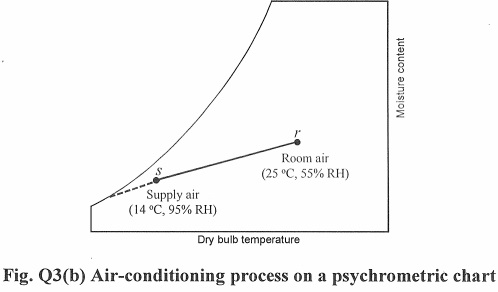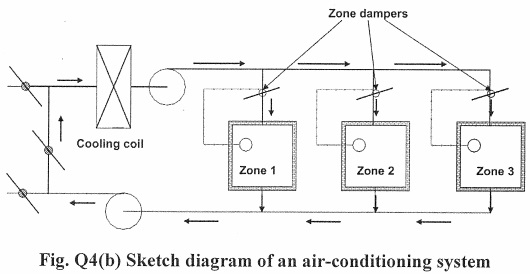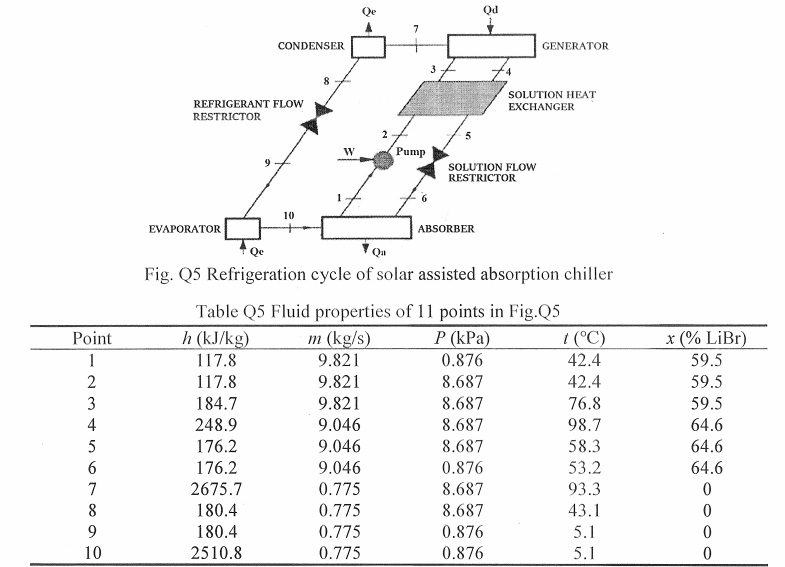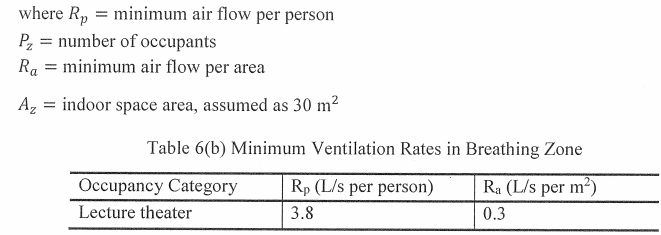Reference no: EM133024019
SEHS4626 Air Conditioning for Indoor Thermal and Environmental Quality - The Hong Kong Polytechnic University
Question 1
(a) Cooling tower observations at an industrial site were
- Cooling water flow rate: 1000 kg/s
- Cooling water inlet tclnpcrature: 43°C
- Cooling water oiitlet tcm|aeratiire: 36°C
- Ambient air dry-bulb temperature and relatively humidity: 30°C, 55%
- Moist air is exhausted at 21°C, 95% relative hiimidity.
The specific heat capacity for water is 4200 J/kg K. The specific heat capacity for dry air is 1.01 kJ/log K. Calculate the (1) Approach, (2) Cooling Capacity, (3) Rangc. (4) Cooling Tower Effectivencss and (5) Liquid gas (I./G) ratio.
(b) Two identical water pumps in a chilled water system are connected in series. For each water pump, the design flow rate and pump pressure are 80 Us and 200 kPa, respectively. To reduce the energy consumption, the pwnps are installed with variable speed drive. If both water pumps are running at 70% rated speed, calculate the theoretical power reduction of the whole system.
Given:
Function Speed Change Impeller diameter change
Flow Q2 = Q1(N2/N1) Q2 = Q1 (D2/D2)3
Pressure P2 = p1(N2/N1)2 P2 = p1 (D2/D1)2
Power P2 = P!(N2/N1)3 P2 = p1 (D2/ D1)5
(c) In a plant rot›m, the energy consumption of the chiller is 120 kW tinrlei full load. The energy consumption of all tlac Pump and fans are 35 kW. The I4ow rate of chilled water is 94.3 m3/h with inlet temperature 7°C and outlet temperature of 12°C. Caualuate the coffecient oefficient of Performance (COP) of the chiller and COP of the cooling systcm.
Question 2
(a) Given the folio ing infoi'ination, calculate the cooling load due to the indow glass (for both conduction alid solar racliation).
- Areii of the window glass - 8 m2
- U-value of the window glass = 3.6 W m-2K-1
- Cooling load temperature difference (CLTD) for the window glass = 5°C
- Shading coeflicient c f the i› indow Class = 0.75
- Solar ccioling load (SCL) factor for the indow glass: For sunlitw indow area = 126 W/m2 for shaded window area = 50W/m2
sunlit window area = 6 m2; shaded window area = 2 m2
comfort. Calculate the v‹ilue ‹ 1' PPD if the estimated value of PMV is -0.45.
(b) Explain the difference and relationship between PMV and PPD for the study of human thermal comfort. Calculate the value of PPD if the estimated value of PMV is -0,45.
Given: PPD = 100 - 95.e(0.03353xP MV4 -0.2179xP MV2)
Question 3
(a) A lecture theatre is to be maintained at a tempcrature of 25°C dry bulb and 19°C wet biilb temperatures. The sensible cooling load is 88 kW ancl 58 kg per hour or moisture must be relnoved. Air is supplied to the lecture theatre at 18°C. Prr›pcrtics of the air can be found from the psychrometric chart in Appendix. Determine
(i) the mass flow rate of supply air,
(ii) the relative humidity, dew point, and wet bulb temperature of supply air,
(iii) the latent cooling load.
(b) An Office is maintained at dry-bulb temperature 25°C and relative humidity (RH) 55% by an air- conditioning system. The cooling system is supplying 1.2 m3.s-1 of cold air at 14°C and 95% RH. figure (b) shows the air-conditioning process on. a psychrometric chart. Properties of the air can be found from the psychrometric chart in Appendix.

Assume air density p = 1.2 kg m-3, specific heat of air cp = 1.02 kg-1 K-1 water evaporation - 2500 kJ/kg. Calculate the following parameters.
(i) Sensible heat, latent heat and total heat exchange.
(ii) Sensible heat ratio of the process.
(iii) Contact factor and bypass factor of the cooling coil.
Section B
Select am TU'O questions ii oiri Section B, each question carries 20 marks.
Qutesion 4
(a) A 3-story building is equipped with a central air-conditioning system. There are 3 Fan coil Units (FCU) with each serving for one floor. the iloor height, horizontal fioor length and cooling toast of each FCU are shown in Fig. Q4(a). commercial steel pipe (Schedule 40) is used. Determine the size of each pipelinc find total head loss of the critical path. The pipe sizing chart is attached in appendix.

(b) With the aid of thc Fig. Q4(b), explain the we rking pi inciplc of the following air-conclitioning system.

Question 5
(a) The solar assisted absorption cooling system is a sustainable cooling solution which is driven by solar energy. The steam is supplied to the generator to boil the LiBr-water solution for cooling. The refrigeration cycle is shown in Fig. Q5. The fluid properties of refrigerant are listed in Table Q5.
(i) Find the heat input to the generator.
(ii) Calculate the cooling effect produced by the evaporator.
(iii) Calculate the coefficient of perforinalicc (COP) of the cycle.

(b) The sensifale effectiveness of a heat recovery ventilator is 53.6%. The inlet temerature of fresh air is 35°C ancl relative humidity is 50%. The inlet temper of exhaust air is 24°C ancl relative humidity is 60%. The mass flow rates of fresh air and exhaust air are 1.3 kg/s and 1.5 kg/s., respectively. Calculate the outlet fresh air temperature and estimate the energy saving ratio of adopting heat recovery ventilator.
Question 6
(a) If 50 students are attended in a lecture cloing low activity work. Assuming per fect mixing of indoor air in the Lecture Theater with volume of 100 m . SF6 is used as tl acer gas testing in a Lecture Theater. At the beginning of test, concentration of SF6 is detected as 10 {rpm. 40 minutes later, concentration of SF6 is reduced to l .5 p|am. Determine the measured air change her hour in the Lecture Theater.
(b) Evaluate hether the ventilation rate obtained in Question 6(a) fulfills the ASHARE standards by using the following equation
nV = RpPz + Ra Az
Table 6(b) Minimum Ventilation hates in Breathing Zone
(c) A HAVC system piovides supply air volume flow of 300 L/s to a room of dimensions 10 m (width) x 6 m (length) x 3.5 m (height). Calculate the air change per hour (ACII).

Attachment:- Indoor Thermal and Environmental Quality.rar